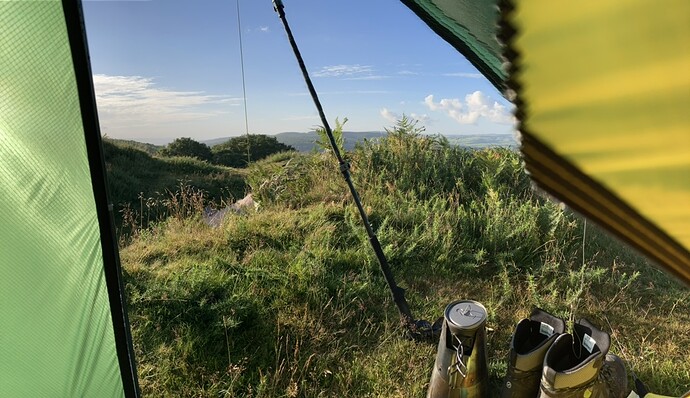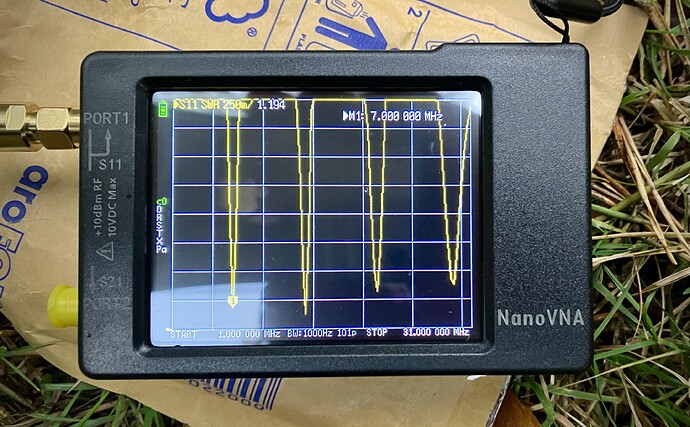Blimey, I have a lot of responding to do - that’ll teach me not to log off.
First of all, thanks for helping. So, in order:
@MW0CBC - Looking forward to trying the same EFHW, though I opted for BNC after a faff incident with an SO239 which wouldn’t become undone due to my cold hands. I have some personal timber to lose, after sitting at a desk for 2 years during the C****-19 response. 
@G4TGJ - Lesson learned. Warm jacket now sits at the top of my rucksack, and comes out first. Did that at High Willhays (second attempt) and I lasted way longer. Also, I don’t plan to use an ATU given I can sweep the antenna with my Nano VNA and get things right first. ‘Caperlan’ pole on its way.
@DD5LP - I meant the physical length of it… rather than the band. Will take the Nano VNA with me on outings to check SWR troughs before keying up. I’ve seen reviews regarding the mic - so already making mental plans for something better if I need it. 
@G4OIG - LOL! The antenna is for POTA or home use. Great on RX, it’s good for listening at home - most certainly not using it on summits! It needs a bit of work before it’s usable for TX. I’m a big fan of walking poles, so very keen to make use of them on summits.
@G5OLD - Thanks. Already got an EFHW arriving today, so I’ll try that first. Hoping to get it resonant on 40/20/10. My 3Ah battery apparently has built-in protection and seems good, but I’ll re-wire the input and output cables to include a fuse, better protecting from a short. If I have issues with AM broadcast, I’ll stick to 2m and use my SOTABEAMS filter for starters… eventually building my kit up for HF.
@M6GYU - I was sort of thinking the same regarding aerial support. I have a 9.5ft mast, and a 16ft mast arriving based on my reading and some compromise. Guys can be an issue depending on the ground, so it’s good to try something else. I have a sit mat, always in the rucksack. I also always carry a foil blanket, though I might opt for a foil bag given it might be better for personal emergencies. Rain? What rain? 
@HB9GVW - A pileup would be lovely. At the moment, all I want is to be able to get a signal out. Tried on 20m with the hideous metal contraption and I failed. This things appears just to be a dummy load. I live in a dip though, so a vertical antenna at low height wan’t going to work realistically. Still, it’s good to play.
@G4OIG - In steeper/colder terrain, I have carried a survival bag with a lightweight sleeping bag just in case. Never had to use it, but I did almost consider it when it suddenly started snowing up on the peaks, and visibility dropped considerably. Managed to retreat with compass bearings, but at least I had the kit to keep me alive for a few hours should that have been unsuccessful.
@M0VUE - Looking forward to receiving the antenna today and having a play (though I have patch leads to construct first - I don’t have a BNC to BNC). Looking forward to it.
So, my carry kit so far based on recommendations (and some aspiration to experiment):
1- G106.
2- Battery pack. Fuse to be added for additional protection.
3- EFHW. Method of attaching to mast yet to be procured.
5- *4m BNC to BNC patch lead (dual purpose - connect to EFHW or 2m flowerpot).
6- Nano VNA.
7- Mast (5m - a compromise to enable 2m use). Guys yet to be procured.
8- Walking poles (to be used with EFHW).
9- Warm layers (incl beanie and gloves). Waterproof layers.
10- Sit mat + foil blanket + compass (foil blanket to be replaced with foil survival bag in future).
11- Food + Water. HOT drink option likely to be my Caldera Cone stove kit.
12- My usual 2m kit - 771 antenna. 770 antenna. *Shortened flowerpot to make use of the BNC to BNC patch lead. Only one 2m HT to be carried if I’m carrying my HF kit.
13- Log book.
14- Fully charged phone with OS maps pre-installed.
I’m sure there’s something missing - but that’s what I’ve come up with so far.

